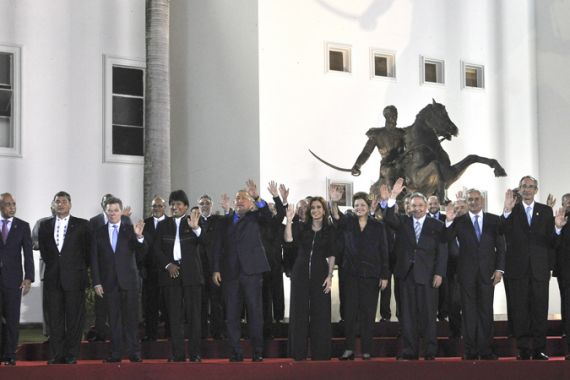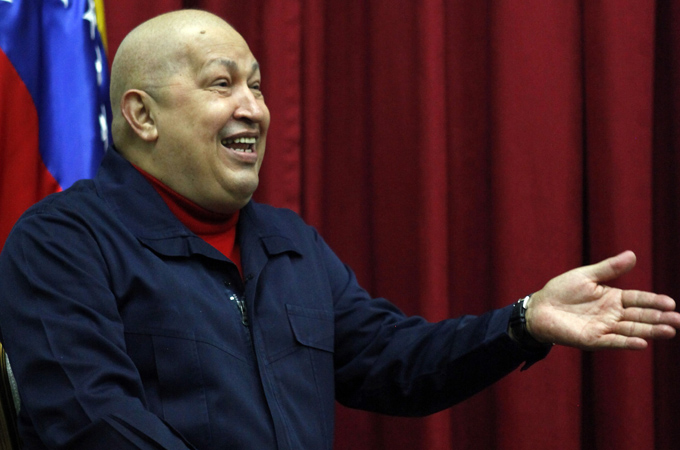Good times down Latin America’s way
The outlook for Latin America remains positive in 2012 – despite reduced Chinese and Indian demand for raw materials.

 |
| The health of Venezuelan President Hugo Chavez will remain a key issue in Latin America in 2012 [EPA] |
Mexico City, Mexico – For Latin America, 2011 was, in Frank Sinatra’s terms, a very good year – and 2012 doesn’t look like being so bad either. For a region not always accustomed to things going well, this is a somewhat strange state of affairs.
Three elections were held in Latin America in 2011. Two – in Argentina and Peru – went well; the other – in Nicaragua – was marred by egregious fraud and heavy-handed government intervention in favour of the incumbent. Still, two out of three is not bad in a region where, previously, if elections were held at all, disputes about the outcomes were the norm.
In economic terms, high commodity prices fuelled strong growth in South America in 2011, and the modest US recovery benefited nearby countries. In Chile, Peru, Argentina, Uruguay, Bolivia and, to a lesser extent, Brazil and Colombia, voracious Chinese and Indian demand for raw materials and food boosted foreign reserves, enabled heavy government spending, and sustained high levels of imports. All this led to average growth rates well in excess of four per cent.
But it also led to new doubts about the wisdom of reliance on commodity exports. Chilean economist and politician Carlos Ominami, in his tell-all memoir Secretos de la Concertación, wondered what would happen if China’s economy slowed or its real-estate bubble burst. By the end of the year, this seemed to be happening: commodity prices and growth rates were dropping, and 2012, while still promising strong economic performance, will not match this year’s success. Sustained lower prices may bring chickens home to roost.
The outliers were Venezuela, despite high oil prices, and the Caribbean Basin: Mexico, Central America, and the islands. These countries export manufactured goods to the US, on which they also rely for tourism and remittances; they lack either the geography or the geology to become great commodity exporters (or, like Mexico, they export all of their oil to the US).
But even the outliers enjoyed decent growth this year. If the US avoids a new slowdown, they may do better than South America in 2012. All told, with the exception of 2009, the entire region will have experienced a full decade of uninterrupted growth – something not witnessed since the 1970s.
The boom fuelled expansion of Latin America’s middle classes. Between 1950 and 1980, most Latin American countries’ middle classes comprised between one-quarter and one-third of the population. Then came the debt crisis of the 1980s, the extreme structural reforms and financial collapses of the 1990s, and a new global downturn in 2001. Such traumatic events plunged these countries into the so-called “middle-income trap”: unable to grow or to continue broadening their middle classes.
But, by the second half of the 2000s, everything changed: prolonged macroeconomic stability, competent centre-left or centre-right governments, sensible social policies, and global economic growth allowed countries such as Mexico, Brazil, Chile, Uruguay – and even Argentina – to take the next giant step. By 2008 or so, around 55 per cent of these countries’ populations belonged to the middle class, by whatever definition one used.
Access to credit, more jobs, remittances, the commodity boom, and conditional cash transfers enabled millions to purchase a home, a car, and a better life. This was not a middle class modelled on North Atlantic precedents, and its members’ status is precarious and reversible; moreover, their standard of living is well below that of their counterparts in wealthier countries. But a middle class it is.
These middle-income sectors make up an even larger part of the electorate, since their turnout rates are higher than those of the poor. Political candidates must engage them, occasionally pander to them, and tailor their message to them, all of which steers leaders and parties toward moderate positions. There are no guarantees that this will endure, but it is one of the region’s most impressive achievements in recent years.
Latin America will witness two important elections in 2012, in Venezuela and Mexico, and one non-election, in Cuba. In Venezuela, President Hugo Chavez’s opponents will unite behind a single candidate for October’s presidential election. But everything depends on Chavez’s health, which, like that of Fidel Castro in Cuba, is a closely guarded state secret.
Will Chavez’s cancer allow him to run (he is as formidable a campaigner as he is a terrible economic manager), win, and govern until 2030? Will he be a stand-in for his more radical brother (and designated successor), Adan? Or will he be too ill to participate? In that case – and most importantly – would he, Adan, and the entire “Bolivarian” elite accept defeat at the polls?
In Cuba, there will be no elections, but matters may come to a head next year. Raul Castro’s economic reforms have either not been implemented, or are not delivering the expected results; the island continues to depend on Venezuelan subsidies, remittances from Miami, and European tourists.
Cuba’s octogenarian ruling brothers cannot last forever. Something may have to give on the island, especially if their Venezuelan benefactor is no longer in power.
Then there is Mexico, which will hold only its fourth democratic election in its history in a context of rampant organised crime, appalling violence and rising scepticism about President Felipe Calderon’s war on drugs. With three contending parties, a terrible electoral law, no run-off, and considerable frustration with 12 years of centre-right, often ineffective governments, the outcome is highly uncertain.
That said, Mexico’s political institutions have survived hard times, the middle class rejects extremism, and the US is close by. One would prefer to see Mexico’s presidential candidates offer platforms with ideas and proposals that respond to the challenges facing the country, but this substance deficit occurs everywhere now, almost all the time.
For a region that has suffered so long from frustration and despair over its failures, these are among the best of times. Latin America should count its blessings, and remember that nothing lasts forever.
Jorge G. Castaneda, former Foreign Minister of Mexico (2000-2003), is Global Distinguished Professor of Politics and Latin American Studies at New York University.
A version of this article previously appeared on Project Syndicate.
The views expressed in this article are the author’s own and do not necessarily reflect Al Jazeera’s editorial policy.
